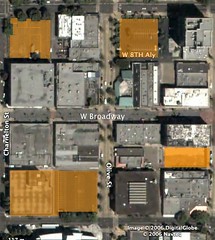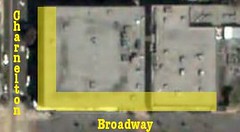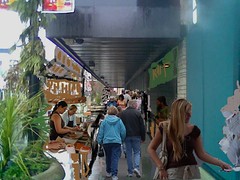|
|
Let's not tear down any more buildings. Let's preserve and nurture all the existing tenants downtown. Let's put the unfilled property into a community trust, and put the tenants in charge of keeping the properties occupied, maintained, public-minded and alive.
More specifically: the City of Eugene exercises its options, and buys any available Conner-Woolley properties, which currently are those on the south side of Broadway between Willamette and Charnelton.
The property is then managed by its tenants, in order to quickly fill the remaining spaces, and develop them, with the maximium community participation and positive public effect.
A name for the self-managed, publicly-minded tenant group: "The Downtown Community".
It would be responsible directly to the City Council.
The properties would reside in a City-owned trust, to give the Collective more flexibility to use volunteer & student labor to develop the spaces.
The initial tenants, the current ones, are themselves among the best networked coalitions in town. The management community would be formed from this larger participatory body. (Tenant participation is not mandatory). Non-tenant collective membership will be available for other downtown organizations & friends of downtown. |
|
|
The City of Eugene obtained purchase-options, on a number of buildings downtown. Normally these would be used to negotiate a large development package ... but this approach is both unlikely to succeed (having in 10 years only stimulated a single private building project downtown) and undesirable (since the result is unlikely to reflect the city's character).
Among the buildings now available for purchase by the city, are the properties that have most usually been considered "locked up", because the owners, the Conner & Woolley families, do not find it financially feasible to invest in improving the facilities, in coalition with existing or potential local tenants.
So perhaps the Conner/Woolley portion, of the options, is the most important potential purchase by the City.
In this proposal, under city ownership, the buildings will be managed by the tenants of the buildings, in a tenant-community Downtown Collective. The property would be moved to a City-owned private trust, to allow the Downtown Collective the greatest flexibility, for example to use volunteer or student labor, to make improvements and develop activity. The Downtown Collective would also have a non-tenant membership body, and the tenant mangement body would act in mutual benefit with these other downtown groups. The Downtown Collective would officially fall under the final control of Eugene's City Council. It would have City financial tools available to it, under City discretion, to manage and incubate the spaces, in the most efficient way possible, as measured by regular monthly analysis.
The Downtown Collective would broaden to include any new tenants in the trust properties. The collective is thus self-perpetuating, as tenants work hard to make their individual projects succeed through a continuous fabric of activity that attracts and satisfies the public.
Given the above criteria, the following organizations, all tenants, would be eligible for the core of the Downtown Collective: Saturday Market, Lane County Farmer's market, DIVA, The Tango Center, The Jazz Station, The New Zone Gallery, Downtown Events Management, Inc., Quan's Restaurant, ShawMed, Vrijmoet Design, Quote Software and Pivot Architecture. Participation is of course optional. Note that protecting, and enhancing, the current tenant's activity is paramount for the coalition.
Note that among the tenant members, the non-profits and co-ops in this list are themselves coalitions of many other local Eugene groups. These are automatically invited to participate as tenant members.
The purchase of these buildings, and the formation of a political body to manage them, will itself bring immediate and intense interest to downtown Eugene, both locally and internationally. |
Comments
Register. in the top-right corner.
Click add at the bottom of this list.
Speak freely.
|
|
|
How to make a Great Street
In the Register-Guard this morning, Ed Russo wrote:
City officials hope to use the options in order to spur interest in remaking the two-block area and its vacant storefronts into a bustling stretch of shops and cafes. [my emphasis]
We are not very far from this. The organizations and businesses on this street can already achieve this vision, given extra financial tools and city support. Instead, they are under threat.
For example, DIVA could use money to promote and enhance its educational program, to pack its classes. With money for another program coordinator, it could pack its calendar with unusual events. With extra cash, the Jazz Station could be open all the time, and host more jam sessions for the public. The Tango Center needs a bistro, so it can stay open all the time, offering thousands of people a place to social dance throughout the day & night. The ground level of Center Court could be packed with craft workshop / showcases, so local craftspeople could become more public with their work, teach the public, and work together with others in this fashion until the wee hours of the morning.
New construction isn't necessary. Developers aren't necessary. Collective action & management is.
November 28, 2006 11:35 AM |
Extending the scope
This proposal covers the CW footprint given the options negotiated by City staff.
But, clearly, the ground floors of the other two CW structures (the former Symantec and call center buildings) are critical to create a continuous fabric of activity on Broadway. Unless it is possible to option these ground floors, or include them through a lease arrangement, the best we can do is hope that our efforts, to fill the other buildings, will inspire investments in activity, within the non-optioned buildings.
November 28, 2006 6:33 PM |
Initiative process
With announcements that the City is planning to tear down more buildings, abandon perfectly decent buildings of its own, and spend upwards of $100 milllion to build itself new facilities, on the sites of existing structures and businesses, it may be time to organize a "common sense city planning" initiative. The City's initiative procedures can be found here.
December 20, 2006 6:34 PM |
|
|
West Broadway
The citizens reject the City's demolition plans, by a huge margin: 63% to 36%. Now, finally, without threats of annihilation, we can do the proper work of filling the gaps, making many small improvements, and creating a natural, lively downtown. We can also work on fixing the city government, by eliminating the powerful City Manager position, and making Staff directly responsible to elected officials. |
|
Principles & Patterns
Some guidelines for the tenant collective
|
|
|
People first
City Planning is a Human Rights issue. The people who live & work in an area under plan, should be protected. Moreover, their opinion should be weighed more heavily than the professionals, the planners, the financiers, and the developers, who known less, simply because they are not resident, and have no experience in the area. It's important to keep empowerment in the forefront of any discussion of civic improvement. The alternative is authoritarian, insensitive, and has a higher chance of failure. |
Preserve existing organizations
Thousands of people have helped to create the functioning organizations in the footprint properties. The Downtown Community will enhance these operations. Good community organizations will make good changes to a building, and usually outlast buildings. So, it's important to concentrate on helping people and organizations, before considering building rennovations. It's important to respect and cherish the massive efforts and sacrifices of people at the grassroots. |
Incubate Public-Interactive Activity
For empty space, find local organizations that can provide maximum interaction and interactive benefit to the public. Find local organizations who already have a large base of support, world-class local practitioners, and would mesh well with the fabric of community organizations, businesses and activities already downtown. |
Buildings: work with what you've got
Many buildings have sat empty for many years. Many businesses have failed. It's generally accepted that it is too difficult for a new business to succeed by itself, without a complete neighborhood, without a surrounding critical mass of continuous occupancy. So it's important to fill the space we already have, and keep it from emptying again. Although some modificatiopns will be in order as tenants require them, it's important to put occupancy, and hard-working occupants, first -- not expensive planning, building and development notions. |
Keep it filled. Keep it alive.
Even while a search proceeds for permanant tenants, the Downtown Community needs to rent empty space and keep it active. This could mean events, flea markets, conferences, indoor sports ... all kinds of programmed actvities are appropriate if it brings people downtown, and maintains a lively fabric. |
Maximize grassroots participation
Among existing tenants, some already represent coalitions of organizations: artists, dancers, musicians, farmers, food vendors, craftspeople etc. New or old organizations that will fill currently unoccupied space, need to also have this amplified support among Eugeneans. Such groups spark interest among more people, in downtown's success. |
Incubate local economic activity
Filling physical space provides an opportunity to find talented locals, and give them a chance to interact with the public and catalyze economic activity. This is something that Saturday Market does quite well, and with more space, visibility, permanence and mutual support, world-class micro-economies can form around some of Eugene's favorite activities.
Imported goods are becoming increasingly expensive. This is an opportunity for local producers to sell to our own market, keeping money in the local economy. |
Tenant-driven incremental improvement
When organizations or businesses are active, and need to adjust their space, to improve it, or to grow it, that's a real force that calls for some construction. This is incremental physical improvement originating from people, from real needs, and real use. Contrast this with the speculative activity usually used to justify large-scale, "Urban Renewal"-style demolition and construction. |

Fill the existing holes ...
... with housing. Destroying more buildings is wasteful ... but the existing holes and surface parking can be filled with housing projects, bringing residents downtown. |
Mostly local
City money should mostly support the activity of its citizens. If the actiivty within downtown is local, then the money spent, at local stores or non-profits, remains in the community. Local organizations and talent should be solicited for downtown projects, but this may be in coalition with national and transnational groups. As an example, say that local Appropriate Technology people create a street-level school / workshop / incubator dedicated to locally-made tools. They's probably want to partner with Cottage Grove's Aprovecho Institute, Eugene's Center for Appropriate Transport, and London's Intermediate Technology Development Group, etc. They could co-administer and manage their space together, creating a very Eugene, world-class facility. |
Common misconceptions about
downtown revitalization
|
|
|
"Tenants can just move"
Why should tenants need to move? Actual people have worked incredibly hard to fill downtown with life -- preserving their efforts is much more vital to the life of downtown than random ideas from planners, architects or developers. The existing tenants are literally the only realistic starting point. |
"We need density downtown"
Actually, we need the empty space filled. We don't need more of it.
The current volume of space was successful in Eugene, when the local market-size was even smaller than today. We have a heterogeneous, differentiated downtown geometry, much as it has always been. Some taller buildings were unfortunately demolished during the dark days of Urban Renewal. But on the Conner/Woolley properties under discussion, that is not true (except for the Aster hole on Willamette). The homes of the Tango Center, DIVA, and the Jazz Station, for example, are in pre-urban-renewal buildings.
Why build new structures in these spaces, when a process for filling them has not been created? The result of new construction, is more expensive space, and more of it. It's also less likely to be filled, partly because the work of existing organizations will be gone. Massive new construction is simply not practical, and is quite destructive. |
"Clean up downtown"
This is the latest euphemism for chasing kids and transients from empty storefronts.
These people hang in front of these spaces because they are empty. It's an easier place to meet, because no one bothers them there. If the spaces are filled (all at once) almost all of them will move somewhere more private.
Also, consider -- does their natural desire to get together, provide us an opportunity to, in some poitive way, re-integrate these kids into the community? For example, with a large number of active workshop / showcases at ground level (metal work, carpentry, plumbing, ceramics) they may find some new activity that inspires them, which they can join in. This is, in fact, the traditional approach to the problem, and it used to work quite well, before street-level craft disappeared. |
Application for downtown space
If you or your organization has interest in creating a centers of activity within the existing buildings downtown:
Register in the top-right corner of this page, and submit a brief summary of your individual or group preliminary proposal, by clicking Add at the bottom of this list:
|
|
|
Project ideas
Some interesting ideas for filling the existing buildings downtown
participants: 3
|
|
|
Healthy markets
In some cases, the collective may not be able to convince property owners to create publicly-active space at street level, from inside their buildings.
This may be true for a very long and problematic section along Broadway and Charnelton, across from the Tango Center.

But perhaps we can liven the street in other ways. Let's assume that the collective proposal moves forward, and other empty spots are filling up downtown, and the level of activity in existing projects is increaing with City help.
Perhaps a semi-permanent market in this area could make it come back to life, provide some jobs and economic opportunity, and bring yet more people downtown.
 | 1 |
Public workshops
Workshops are educational, and excellent showrooms for local handcraftspeople. Many of the Saturday Market craftspeople might be interested in starting small school / showroom / workshops downtown. They can be open all hours, and raise the visibility and economy of the crafts involved. Ceramics, glass, carpentry, carving, metalwork, casting, custom electronics, plant extraction, looming, natural dyes, tool-making, utensil-production ... there's a huge list of useful items that can be manufactured downtown, on a small scale, at a reasonable prices, from local materials. | 2 |
Eugene Central
The Eugene Central proposal
A Eugene cultural center in the heart of town
It's across from a statue of Eugene's accepted cultural icon: Ken Kesey, and Kesey Square. Pack the building, with organizations and actvities people associate strongly with the man and his passions. | 3 |
Theatre / film production
ACE Cabaret, Lord Leebrick, Willamette Rep, other groups resident at the Hult Center, and local filmmakers, offer a base for local organizations of playwrights, actors, directors, editors, set builders, costumers, lighting people, sound engineers etc. If warranted, these could have their own space, offering equipment and expertise for rent and sale, classes, etc., and they could stage events, promote productions, and generally supports an economy (and maybe even housing) for these specialists. The more concentrated these are in one area, the better. | |
Demonstration spaces
Temporary, street-side demonstration / participation spaces, rather like the ironsmith at Saturday Market, or glass blowers from Eugene Glass School, or plumbers, electricians, electrical engineers, machine-builders, tool-makers, programmers ... demonstrating for a few hours, advertising themselves, selling their wares, getting the word out about what they do, and how they do it. | |
Public guildhalls
Plumbers, electricians, carpenters and other licensed professionals, can open small schools for teaching the public, which double as recruiting halls for professionals -- a great way to expose a lot of people and find talented, energetic, enthusiastic apprentices. | |
"Made in Eugene" stores
Category-based group stores of Eugene-made goods:
*food
*clothing
*furniture & housegoods
*gifts
Perhaps booths, or simply consignment. | |
At-Risk-youth school and opportunity center
Across from the Tango Center, on the ground floor of the old Symantec/Bon-Marche building, where the youth already hang out. | |
DIVA video promotes West Broadway arts district
http://www.youtube.com/watch?v=9M-KBRxIzD0 | |
your video left out
Getting the City of Eugene involved is a mistake. They are the folks who made the downtown a ghost town. The real solution is to appeal to businesses and investors. There was no mention of the 30-60 min. parking downtown in the video either. Also Ken Kesey was a dirty bastard. There are dozens of better locals who deserve praise. In conclusion, where will the homeless youth go if downtown was to be changed? Or will they go at all? | |
|
|
Simulation
A simulation of the process of West Broadway revitalization, for one year. | |
| | | |
|